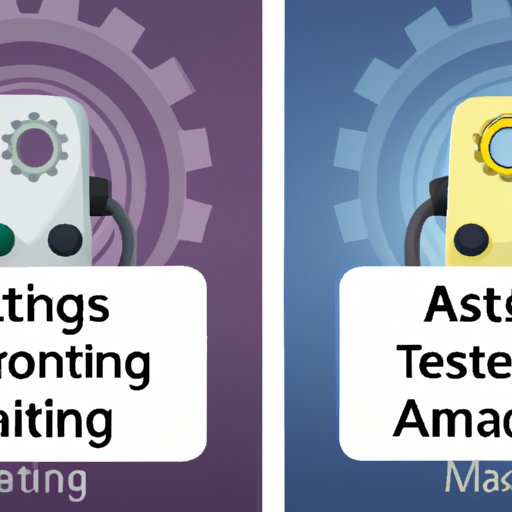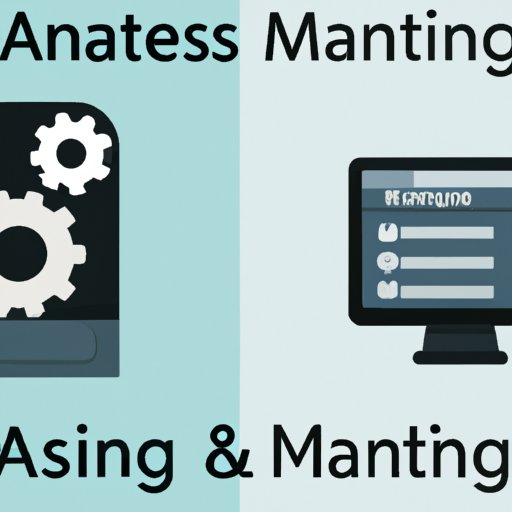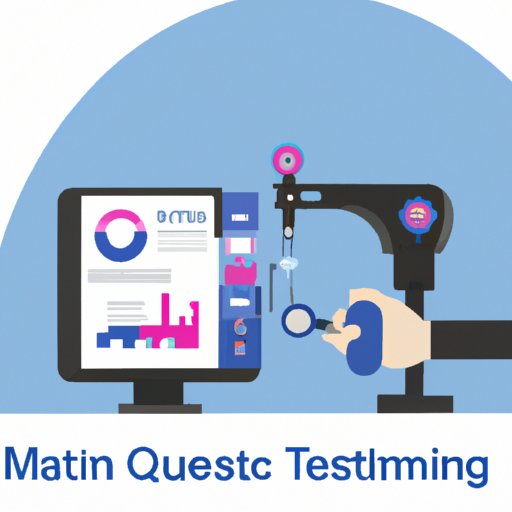Introduction
Software testing is an essential part of software development, as it helps to ensure that the software meets the required specifications and runs properly. There are two main types of software testing: manual testing and automated testing. Manual testing is the process of manually executing test cases without the use of any automation tools or scripts. Automated testing is the process of using specialized software to execute test cases automatically with minimal human intervention.
The purpose of this article is to explore the differences between manual and automated testing, compare the pros and cons of each, and provide best practices for implementing an effective testing strategy. We will also look at a case study of a company that made the decision to use manual and/or automated testing.

Comparison of Manual Testing vs. Automated Testing
Manual testing is the process of manually executing test cases without the use of any automation tools or scripts. This type of testing requires a tester to manually test all aspects of the application, including its functionality, usability, and compatibility. Manual testing can be time-consuming and labor-intensive, but it is still an important part of the software development process as it allows testers to identify bugs and other issues that automated testing may miss.
Automated testing is the process of using specialized software to execute test cases automatically with minimal human intervention. Automation tools can help reduce the time and effort needed to complete tests, as well as increase accuracy and reliability. Automated testing can also be used to perform more complex tests that would be difficult or impossible to do manually. However, automated testing can be costly and time-consuming to set up, and it may not always be the best option for every situation.
When comparing manual and automated testing, there are several factors to consider. Manual testing is typically cheaper, faster, and easier to set up than automated testing. It also allows testers to have more control over the testing process and to tailor tests to specific needs. On the other hand, automated testing is often more accurate and reliable, and it can be used to test more complex scenarios. Additionally, automated tests can be run multiple times, making it easier to identify bugs and other issues.
Exploring the Benefits of Manual and Automated Testing
Manual and automated testing both have their advantages and disadvantages, but they can also offer many benefits when used together. Here are some of the most common benefits of manual and automated testing:
Cost Savings
One of the biggest benefits of manual and automated testing is cost savings. Automated testing can save money in the long run by reducing the amount of time and resources needed to complete tests. Additionally, automated tests can be run multiple times, which can help identify bugs and other issues quickly and efficiently.
Increased Efficiency
Another benefit of manual and automated testing is increased efficiency. Automated tests can be run quickly and reliably, allowing testers to focus on more complex tasks. Additionally, automation tools can help reduce the amount of time and effort needed to complete tests, freeing up resources for more important tasks.
Improved Quality Assurance
Lastly, manual and automated testing can help to improve quality assurance. Automated tests can be used to quickly and accurately identify bugs and other issues, ensuring that the software meets the required specifications. Additionally, manual testing can help to uncover issues that may be difficult or impossible to detect using automated tests.
Case Study: Choosing Between Manual and Automated Testing
In order to decide whether manual or automated testing is the right choice for your project, there are several factors to consider. These include the complexity of the application, the size of the team, the budget, and the timeline. Additionally, you should consider the type of testing that needs to be done, as some types of tests may be better suited to manual or automated testing.
For example, consider a company that is developing a web application. The application is relatively small, with only a few features, and the team is relatively small as well. In this case, manual testing may be the best option, as it will be faster and easier to set up than automated testing. Additionally, manual testing will allow the team to tailor tests to the specific needs of the project, ensuring that all aspects of the application are tested properly.
Common Mistakes in Manual and Automated Testing
No matter the type of testing, there are certain mistakes that should be avoided. When it comes to manual testing, one of the most common mistakes is overlooking edge cases or failing to thoroughly test all aspects of the application. Additionally, manual tests can be time-consuming and labor-intensive, so it’s important to plan ahead and make sure that the right resources are available.
With automated testing, one of the most common mistakes is relying too heavily on automation. Automation tools can be helpful, but they can’t replace manual testing entirely. Additionally, automated tests can be expensive and time-consuming to set up, so it’s important to make sure that the right tools are chosen and that the tests are designed properly.

Best Practices for Implementing Manual and Automated Testing
In order to get the most out of manual and automated testing, there are certain best practices that should be followed. Proper planning and design are essential for both manual and automated testing. Additionally, it’s important to choose the right tools and define test objectives before beginning testing.
Proper Planning and Design
Before beginning testing, it’s important to plan and design the tests properly. This includes defining the scope of the tests, identifying the resources needed, and establishing the testing requirements. It’s also important to make sure that the tests are designed to cover all aspects of the application and to ensure that the tests are comprehensive enough to identify any potential issues.
Utilizing the Right Tools
For automated testing, it’s important to choose the right tools. Different automation tools have different capabilities, so it’s important to choose the ones that are best suited for the project. Additionally, it’s important to make sure that the tools are compatible with the application and that they have the necessary features to complete the tests.
Defining Test Objectives
Finally, it’s important to define clear test objectives before beginning testing. This includes determining what needs to be tested, how the tests should be conducted, and what criteria should be used to evaluate the results. By defining clear test objectives, testers can ensure that the tests are thorough and that any issues are identified quickly.

Manual vs. Automated Testing: Pros and Cons
Now that we’ve explored the differences between manual and automated testing, let’s take a look at the pros and cons of each. Here are some of the most common pros and cons of manual and automated testing:
Pros of Manual Testing
- Cheaper and easier to set up than automated testing
- Allows testers to have more control over the testing process
- Can be tailored to specific needs
Pros of Automated Testing
- More accurate and reliable than manual testing
- Can be used to test more complex scenarios
- Tests can be run multiple times, making it easier to identify bugs and other issues
Cons of Manual Testing
- Time-consuming and labor-intensive
- May overlook edge cases or fail to thoroughly test all aspects of the application
Cons of Automated Testing
- Expensive and time-consuming to set up
- May not always be the best option for every situation
- Cannot replace manual testing entirely

How to Develop an Effective Testing Strategy with Manual and Automated Testing
An effective testing strategy should combine manual and automated testing in order to maximize the benefits of each. Here are some steps to follow when developing an effective testing strategy:
Define Clear Goals and Objectives
The first step in developing an effective testing strategy is to define clear goals and objectives. This includes determining what needs to be tested, how the tests should be conducted, and what criteria should be used to evaluate the results.
Identify Scope and Resources
It’s also important to identify the scope of the tests and the resources needed to complete them. This includes identifying the tools and personnel needed to complete the tests, as well as any additional costs associated with the tests.
Establish Testing Requirements
Once the scope and resources have been identified, it’s important to establish the testing requirements. This includes determining the types of tests that need to be performed, the level of detail required, and the expected duration of the tests.
Choose the Appropriate Testing Types
Next, it’s important to choose the appropriate testing types. For example, if the project is relatively small and the team is limited, then manual testing may be the best option. If the project is larger and more complex, then automation tools may be necessary.
Track and Monitor Testing Progress
It’s also important to track and monitor the progress of the tests. This includes tracking the results of the tests and identifying any issues or bugs that are discovered.
Analyze Results and Make Adjustments
Finally, it’s important to analyze the results of the tests and make adjustments as necessary. This includes making changes to the tests based on the results and ensuring that the tests are covering all aspects of the application.
Conclusion
Manual and automated testing both have their advantages and disadvantages, but when used together, they can provide many benefits. It’s important to consider the factors mentioned above when deciding whether manual or automated testing is the right choice for your project. Additionally, it’s important to follow best practices when implementing manual and automated testing, such as proper planning and design, utilizing the right tools, and defining test objectives. By following these steps, you can ensure that your testing strategy is effective and successful.
(Note: Is this article not meeting your expectations? Do you have knowledge or insights to share? Unlock new opportunities and expand your reach by joining our authors team. Click Registration to join us and share your expertise with our readers.)
